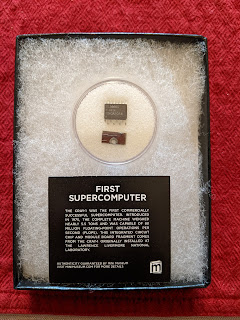The chip is a Fairchild SL56660, a 5/4 NAND gate. The original design only employed four ICs but in huge quantities: this one, an alternative but slower NAND gate, 1Kx1 bipolar SRAMs (usually the Fairchild 10415FC, about 70,000 of them in the 1976 Los Alamos National Laboratory unit), and the specialized Fairchild SL82747. This chip bears a date code of 14th week 1981 and is based on emitter-coupled logic (ECL), making it very fast for the time but also very power-hungry; CMOS made ECL and MECL obsolete. The later date code can be attributed to the fact this was probably from a board installed for repair purposes.
Merry Christmas and a very happy holiday season.Saturday, December 25, 2021
Merry Old VCR Christmas
Signs you married well: your wife buys you vintage artifacts for Christmas, in this case a logic chip and fragment of a PCB from the Cray-1 at the Lawrence Livermore National Laboratory.
(The other chips in this picture are IBM dies from a 90MHz PowerPC 601+ and a POWER9.)
Sunday, December 19, 2021
Monitoring the vintage server room (and reverse-engineering USB sensors)
We're house hunting because of $JOB and $HOUR hour commute, and I just got word that the reseller I contract with for Floodgap's leased line is getting out of that business in mid-January. This makes finding new digs (or at least setting up some sort of temporary static IP alternative) a must because one of the gotta-haves is space for my vintage server room. Sure, you can outsource, or host things on slices, or put things on a rack of Raspberry Pis and call it a day. And admittedly that would probably take up less space, generate less heat, use less power and result in less inconvenience, but where's the fun in that when you can be running your own 2008-vintage IBM POWER6 for mail, web and gopher, or a Sawtooth Power Mac G4 file server, or a 1989 Mac IIci that still happily handles internal network DNS?
Subscribe to:
Comments (Atom)


